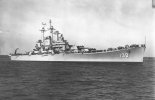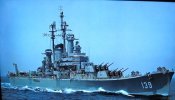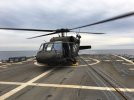-
Please take a moment and update your account profile. If you have an updated account profile with basic information on why you are on Air Warriors it will help other people respond to your posts. How do you update your profile you ask?
Go here:
Edit Account Details and Profile
You are using an out of date browser. It may not display this or other websites correctly.
You should upgrade or use an alternative browser.
You should upgrade or use an alternative browser.
Ship Photo of the Day
- Thread starter Randy Daytona
- Start date
Thought they started adding them when the -60S started deploying, but from your post, am guessing it was a slow process to update deck markings.Nice. Now you're ready to go for the center light.
Anyone know how long the wheel boxes have been a thing? They weren't there in 2011.
Maybe the boxes are there after RASTerizing the ship and repainting the diagonal lines as straight in lines. Online photos show this ship's deck was previously painted with diagonal line up line. Resume says aft tailwheel 60 must land in wheel boxes. I know the wheel boxes in resume have been there for at least a year and a half. It's the first time I've ever landed on one with the boxes though. The forward butt line seems to work out for pilot reference. Dual line up lines on hangar of course only work for left or right RSD, not center landings.
As the anniversary of Pearl Harbor was a few days ago, a few photos of the other battleship that was destroyed, the Nevada class USS Oklahoma (BB-37). Moored outside USS Maryland, it took at least 5 torpedos (some say 9 torpedos) in the side and capsized - some of the sailors were rescued more than a day later from the inside.
Length: 583', Beam: 96', Tonnage: 27,500 tonnes. 24,800 HP gave 20 knots. 10 x 14"/45 cal main armament firing 1,500 lb shells, 21 x 5" secondaries.
Commissioned: 1916, Sunk: 1941, Decommissioned: 1944
http://www.okhistory.org/kids/ussok2.php
PBS did a documentary on her last year, some beautiful clips of the battleline in this short video.
http://www.pbs.org/program/pearl-harbor-uss-oklahoma-final-story/

Oklahoma after her modernization, passing Alcatraz

USS Wisconsin is tied up outboard of the hull of Oklahoma at Pearl Harbor Navy Yard on 11 November 1944. Note the great difference in the length of the two battleships.

USS Oklahoma wearing experimental cmouflage, circa 1917


The Pennsylvania (BB-38) follows other battleships during maneuvers. The first three ships in the background are Nevada (BB-36), Oklahoma (BB-37), and Arizona (BB-39) in that order. However, the photo pre-dates the 1925 Australia/ New Zealand tour since Oklahoma lacks the enlarged lookout stations on the cagemasts.
Length: 583', Beam: 96', Tonnage: 27,500 tonnes. 24,800 HP gave 20 knots. 10 x 14"/45 cal main armament firing 1,500 lb shells, 21 x 5" secondaries.
Commissioned: 1916, Sunk: 1941, Decommissioned: 1944
http://www.okhistory.org/kids/ussok2.php
PBS did a documentary on her last year, some beautiful clips of the battleline in this short video.
http://www.pbs.org/program/pearl-harbor-uss-oklahoma-final-story/

Oklahoma after her modernization, passing Alcatraz

USS Wisconsin is tied up outboard of the hull of Oklahoma at Pearl Harbor Navy Yard on 11 November 1944. Note the great difference in the length of the two battleships.

USS Oklahoma wearing experimental cmouflage, circa 1917


The Pennsylvania (BB-38) follows other battleships during maneuvers. The first three ships in the background are Nevada (BB-36), Oklahoma (BB-37), and Arizona (BB-39) in that order. However, the photo pre-dates the 1925 Australia/ New Zealand tour since Oklahoma lacks the enlarged lookout stations on the cagemasts.
Remember the Maine!
2 months after its sinking, the Spanish-American War began. Originally attributed to a mine explosion and portrayed in the media as such, it now appears likely that the explosion was due to explosive gas from its coal bunkers.
Notice the main guns being displaced to the sides for a greater arc of fire - this proved to be a bad idea for seakeeping, refueling, and blast.
length: 324', beam: 57', displacement: 6682 tons, 9,300 HP gave 16.45 knots
4 x 10" main guns firing 510 lb shells, 6 x 6" secondaries
Commissioned: 1895, Wrecked: 1898


"The Maine entering Havana harbor. January 1898."

Stern view of Maine

Deck plan of Maine
2 months after its sinking, the Spanish-American War began. Originally attributed to a mine explosion and portrayed in the media as such, it now appears likely that the explosion was due to explosive gas from its coal bunkers.
Notice the main guns being displaced to the sides for a greater arc of fire - this proved to be a bad idea for seakeeping, refueling, and blast.
length: 324', beam: 57', displacement: 6682 tons, 9,300 HP gave 16.45 knots
4 x 10" main guns firing 510 lb shells, 6 x 6" secondaries
Commissioned: 1895, Wrecked: 1898

"The Maine entering Havana harbor. January 1898."

Stern view of Maine
Deck plan of Maine
Before the Zumwalt class mounted the 155's (6 inch), the Navy experimented back in 1975 with a lightweight 8"/55 calibre on USS Hull (DD-945, a Forrest Sherman class destroyer) The Mark 71 8" rifle was a derivative of the same cannon on the Des Moines class heavy cruiser, firing a 260 lb projectile at up to 12 rounds a minute.
Length: 407 ft, Beam: 45 ft, Displacement: 4050 tons. 70,000 HP gave 32.5 knots
Commissioned: 1958, Decommissioned: 1983, Struck: 1983




Length: 407 ft, Beam: 45 ft, Displacement: 4050 tons. 70,000 HP gave 32.5 knots
Commissioned: 1958, Decommissioned: 1983, Struck: 1983




The real question from that photo, prompted by looking at the Petty Officer to the right . . . why are we the only anglophone Navy that doesn't let people grow a damn neatly-trimmed beard? Would the world really end if we did the same as the Canadians and Brits?
The real question from that photo, prompted by looking at the Petty Officer to the right . . . why are we the only anglophone Navy that doesn't let people grow a damn neatly-trimmed beard? Would the world really end if we did the same as the Canadians and Brits?
According to a few of the old salts who were in the Navy when you could grow a beard when I was just a mere JO, way too many sailors didn't do the 'neatly-trimmed' part right.
Another survivor of Pearl Harbor, USS West Virginia (BB-48). A Colorado class battleship, it mounted 8 x 16"/45 cal rifles, however the loading mechanisms in these guns only permitted the 2,240 lb AP shells, not the 2,700 lb "Super Heavy" AP shells that the 10 fast battleships of the North Carolina and subsequent classes would fire. Of note, it was these "Super Heavy" shells that were a distinguishing feature of US battlewagons. Roughly speaking, 14" cannons fired 1,500 lb shells, 15" cannons fired 1,800 lb shells and 16" cannons fired 2,200 lb shells - only the US had a Super Heavy 2,700 shell which gave us a distinctive advantage on any other battleship, save the Yamato class.
At Pearl, the West Virginia took 7 torpedos but was counterflooded in time to prevent capsizing like the Oklahoma. It was also struck by 2 bombs made from 16" shells - neither of which (fortunately) exploded. After being repaired, the West Virginia had torpedo bulges to increase its width to 114'. West Virginia got her revenge at the Battle of Surigao Strait under Admiral Oldendorf. At 3:52 am, she opened fire at 22,800 yards, scoring hits on the battleship Yamashiro with her very first salvo and 5 of 6 salvos in all. She served at Iwo Jima and Okinawa, also was present in Tokyo Bay for the surrender.
Length: 683 ft, Beam: 114 ft, Displacement: 33,000 tons. 28,900 HP gave 21 knots (this was the norm for "standard" class battleships)
4x2 16"/45 mains firing 2,240 shells, 8x2 5" secondaries.
Commissioned: 1923, Decommissioned: 1947, Struck: 1959

USS West Virginia (BB-48) in San Francisco Bay, c. 1934

Sailors in a motor launch rescue a man overboard alongside the burning West Virginia during, or shortly after, the Japanese air raid on Pearl Harbor.

West Virginia in July 1944

USS Artisan, a floating drydock, held West Virginia for repairs.

USS West Virginia at Okinawa

At Pearl, the West Virginia took 7 torpedos but was counterflooded in time to prevent capsizing like the Oklahoma. It was also struck by 2 bombs made from 16" shells - neither of which (fortunately) exploded. After being repaired, the West Virginia had torpedo bulges to increase its width to 114'. West Virginia got her revenge at the Battle of Surigao Strait under Admiral Oldendorf. At 3:52 am, she opened fire at 22,800 yards, scoring hits on the battleship Yamashiro with her very first salvo and 5 of 6 salvos in all. She served at Iwo Jima and Okinawa, also was present in Tokyo Bay for the surrender.
Length: 683 ft, Beam: 114 ft, Displacement: 33,000 tons. 28,900 HP gave 21 knots (this was the norm for "standard" class battleships)
4x2 16"/45 mains firing 2,240 shells, 8x2 5" secondaries.
Commissioned: 1923, Decommissioned: 1947, Struck: 1959

USS West Virginia (BB-48) in San Francisco Bay, c. 1934

Sailors in a motor launch rescue a man overboard alongside the burning West Virginia during, or shortly after, the Japanese air raid on Pearl Harbor.

West Virginia in July 1944

USS Artisan, a floating drydock, held West Virginia for repairs.

USS West Virginia at Okinawa

Since you mentioned the 8” on the USS Hull I thought I would mention the USS Salem...the last heavy cruiser built by the US or any other nation. She was built around the 8” 55 Rapid Fire (RF) guns, introduced as a result of the WWII experience. The guns were unlike all previous large (6” or larger) guns, being fully automatic, entirely mechanically loaded, and utilizing metal powder cases instead of the (silk) bagged powder charges of previous US 8” or larger guns. The resultant rate of fire of 10 rounds per gun (rpg) per minute was considered absolutely phenomenal by naval experts. She is a Museum up in Quincy MA these days.





